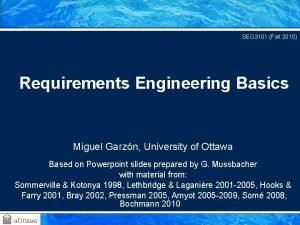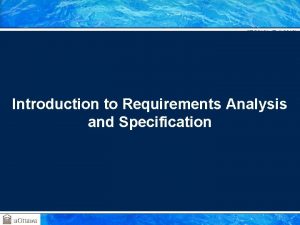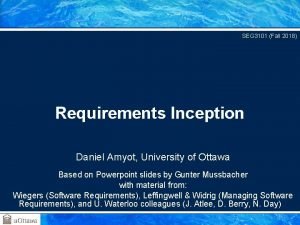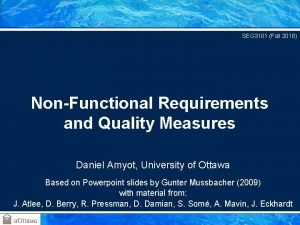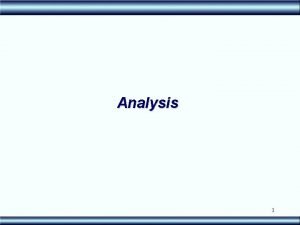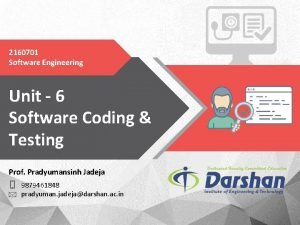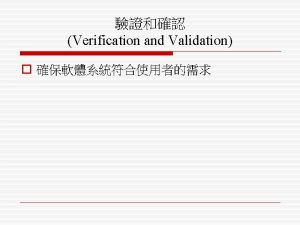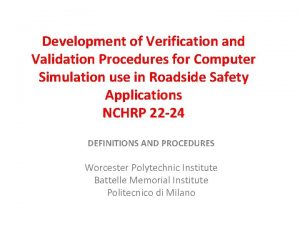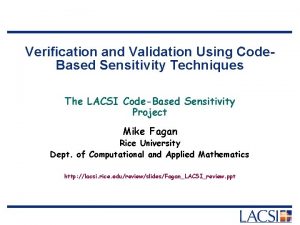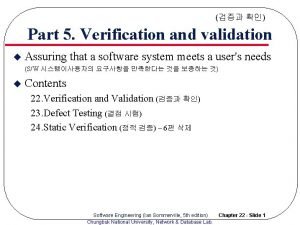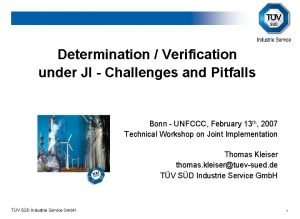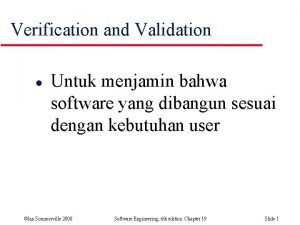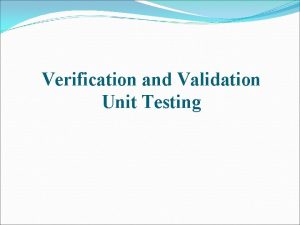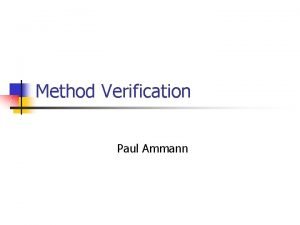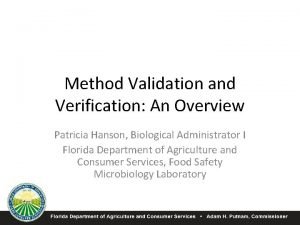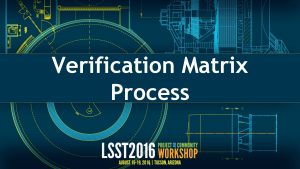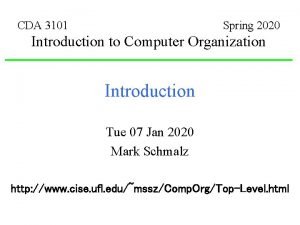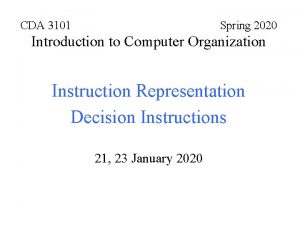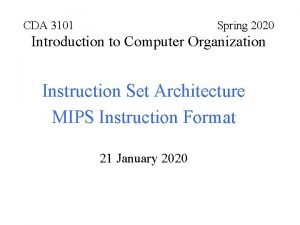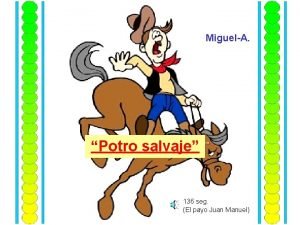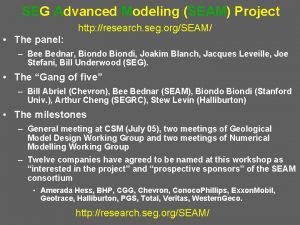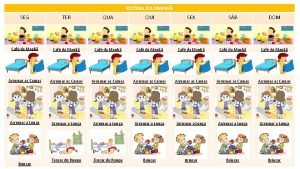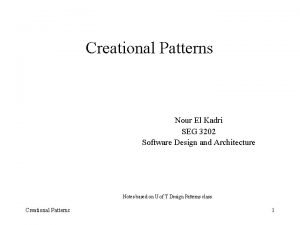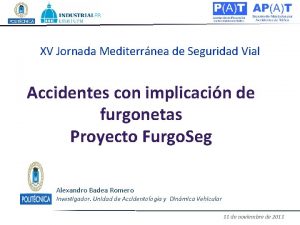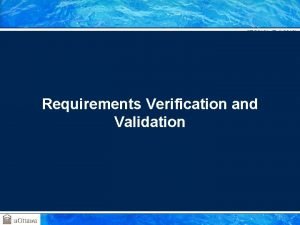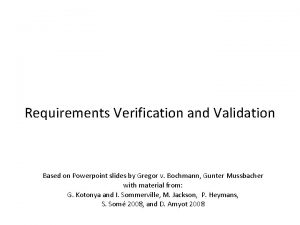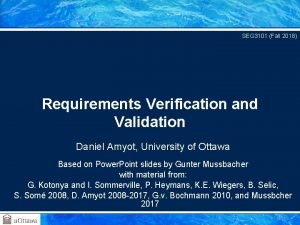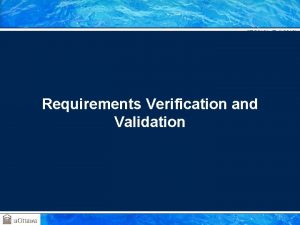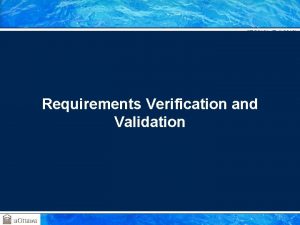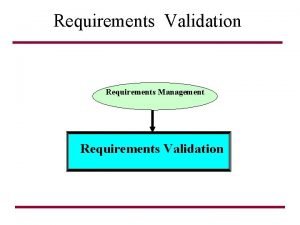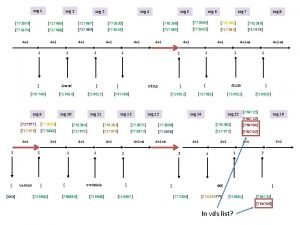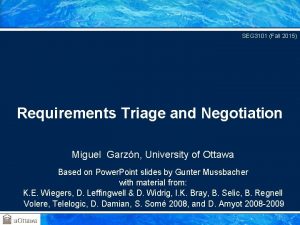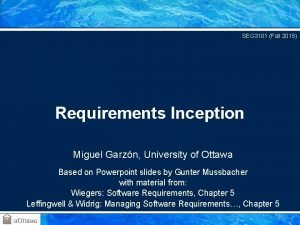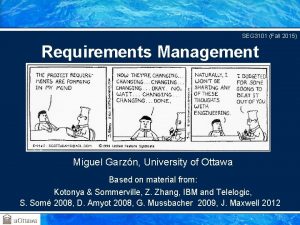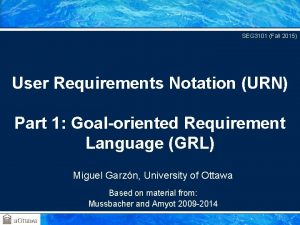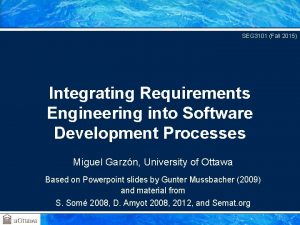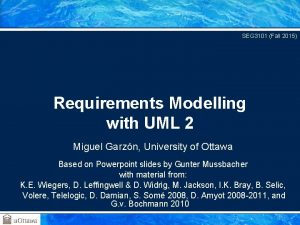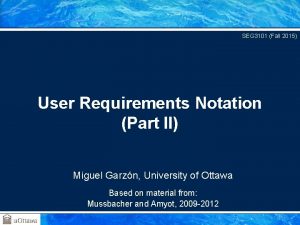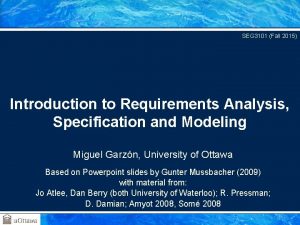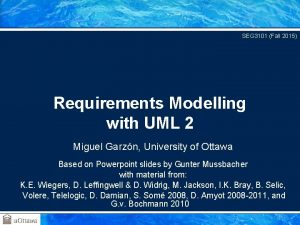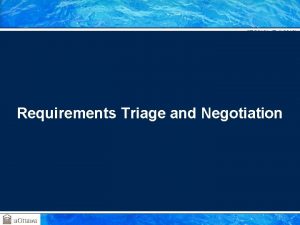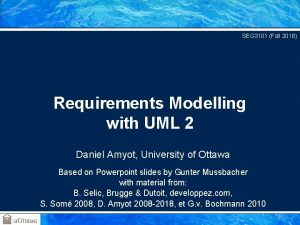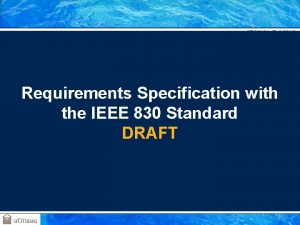SEG 3101 Fall 2015 Requirements Verification and Validation


































- Slides: 34

SEG 3101 (Fall 2015) Requirements Verification and Validation Miguel Garzón, University of Ottawa Based on Power. Point slides by Gunter Mussbacher with material from: G. Kotonya and I. Sommerville, P. Heymans, K. E. Wiegers, B. Selic, S. Somé 2008, D. Amyot 2008, and G. v. Bochmann 2010

Dilbert and Validation SEG 3101. Requirements Verification and Validation 2

Table of Contents • Introduction to Requirements Verification and Validation • Requirements Verification and Validation Techniques • Simple checks • Prototyping • Functional test design • User manual development • Reviews and inspections • Model-based (formal) Verification and Validation • The software is done. We are just trying to get it to work… 1 [1] Anonymous SEG 3101. Requirements Verification and Validation 3

Introduction Simple Checks Prototyping Functional Test Design Formal V&V Reviews and Inspections Requirements Verification and Validation • Requirements Validation • Check that the right product is being built • Ensures that the software being developed (or changed) will satisfy its stakeholders • Checks the software requirements specification against stakeholders goals and requirements • Requirements Verification • Check that product is being built right • Ensures that each step followed in the process of building the software yields the right products • Checks consistency of the software requirements specification artefacts and other software development products (design, implementation, . . . ) against the specification SEG 3101. Requirements Verification and Validation 4

Introduction Simple Checks Prototyping Functional Test Design Formal V&V Reviews and Inspections Requirements Verification and Validation (2) • Need to be performed at every stage during the (requirements) process • Elicitation • Checking back with the elicitation sources • “So, are you saying that. . . ? ” • Analysis • Checking that the domain description and requirements are correct • Specification • Checking that the defined system requirement will meet the user requirements under the assumptions of the domain/environment • Checking conformity to well-formedness rules, standards… SEG 3101. Requirements Verification and Validation 5

Introduction Simple Checks Prototyping Functional Test Design Formal V&V Reviews and Inspections V&V vs. Analysis • Both have several activities in common • Reading requirements, problem analysis, meetings and discussions. . . • But inputs are different! • Analysis works with raw, incomplete requirements as elicited from the system stakeholders • Develop a software requirements specification document • Emphasis on "we have the right requirements" • Requirements V&V works with a software requirements specification and with negotiated and agreed (and presumably complete) domain requirements • Check that this these specifications are accurate • Emphasis on "we have the right requirements well done" SEG 3101. Requirements Verification and Validation 6

Requirements V&V Techniques

Introduction Simple Checks Prototyping Functional Test Design Formal V&V Reviews and Inspections Various Requirements V&V Techniques • Simple checks • Prototyping • Functional test design • Reviews and inspections • Walkthroughs • Formal inspections • Checklists • Model-Based V&V • First-order logic • Behavioral models SEG 3101. Requirements Verification and Validation 8

Introduction Simple Checks Prototyping Functional Test Design Formal V&V Reviews and Inspections Simple Checks • Various checks can be done using traceability techniques • Given the requirements document, verify that all elicitation notes are covered adequately • Tracing between different levels of requirements • Checking goals against tasks, features, requirements… • Involves developing a traceability matrix • Ensures that requirements have been taken into consideration (if not there should be a reason) • Ensures that everything in the specification is justified • Verify that the requirements are well written (according to the criteria already discussed) SEG 3101. Requirements Verification and Validation 9

Introduction Simple Checks Prototyping Functional Test Design Formal V&V Reviews and Inspections Prototyping • Excellent for validation by users and customers • More accessible than specification • Demonstrate the requirements and help stakeholders discover problems • Come in all different shapes and sizes • From paper prototype of a computerized system to formal executable models/specifications • Horizontal, vertical • Evolutive, throwaway • Important to choose scenarios or use cases for elicitation session • Good coverage, not just “playing around” SEG 3101. Requirements Verification and Validation 10

Introduction Simple Checks Prototyping Functional Test Design Formal V&V Reviews and Inspections Functional Test Design • Functional tests at the system level must be developed sooner or later. . . • Can (and should) be derived from the requirements specification • Each (functional) requirement should have an associated test • Non-functional (e. g. , reliability) or exclusive (e. g. , define what should not happen) requirements are harder to validate with testing • Each requirements test case must be traced to its requirements • Inventing requirements tests is an effective validation technique • Designing these tests may reveal errors in the specification (even before designing and building the system)! • Missing or ambiguous information in the requirements description may make it difficult to formulate tests • Some software development processes (e. g. , agile methods) begin with tests before programming Test-Driven Development (TDD) http: //en. wikipedia. org/wiki/Test-driven_development SEG 3101. Requirements Verification and Validation 11

Introduction Simple Checks Prototyping Functional Test Design Formal V&V Reviews and Inspections (1) • A group of people read analyze requirements, look for potential problems, meet to discuss the problems, and agree on a list of action items needed to address these problems • A widely used requirements validation technique • Lots of evidence of effectiveness of the technique • Can be expensive • Careful planning and preparation • Pre-review checking • Need appropriate checklists (must be developed if necessary and maintained) SEG 3101. Requirements Verification and Validation 12

Introduction Simple Checks Prototyping Functional Test Design Formal V&V Reviews and Inspections (2) • Different types of reviews with varying degrees of formality exist (similar to JAD vs. brainstorming sessions) • Reading the document • A person other than the author of the document • Reading and approval (sign-off) • Encourages the reader to be more careful (and responsible) • Walkthroughs • Informal, often high-level overview • Can be led by author/expert to educate others on his/her work • Formal inspections • Very structured and detailed review, defined roles for participants, preparation is needed, exit conditions are defined • E. g. , Fagan Inspection SEG 3101. Requirements Verification and Validation 13

Introduction Simple Checks Prototyping Functional Test Design Formal V&V Reviews and Inspections (3) • Different types of reviews (cont’d) • Focused inspections • Reviewers have roles, each reviewer looks only for specific types of errors • Active reviews • Author asks reviewer questions which can only be answered with the help of the document to be reviewed SEG 3101. Requirements Verification and Validation 14

Introduction Simple Checks Prototyping Functional Test Design Formal V&V Reviews and Inspections Typical Review / Inspection Steps (1) • Plan review • The review team is selected and a time and place for the review meeting is chosen • Distribute documents • The requirements document is distributed to the review team members SEG 3101. Requirements Verification and Validation 15

Introduction Simple Checks Prototyping Functional Test Design Formal V&V Reviews and Inspections Typical Review / Inspection Steps (2) • Prepare for review • Individual reviewers read the requirements to find conflicts, omissions, inconsistencies, deviations from standards, and other problems • Hold review meeting • Individual comments and problems are discussed and a set of action items to address the problems is established SEG 3101. Requirements Verification and Validation 16

Introduction Simple Checks Prototyping Functional Test Design Formal V&V Reviews and Inspections Typical Review / Inspection Steps (3) • Follow-up actions • The chair of the review checks that the agreed action items have been carried out • Revise document • Requirements document is revised to reflect the agreed action items • At this stage, it may be accepted or it may be re-reviewed SEG 3101. Requirements Verification and Validation 17

Introduction Simple Checks Prototyping Functional Test Design Formal V&V Reviews and Inspections Review Team • Reviews should involve a number of stakeholders drawn from different backgrounds • Review team should always involve at least a domain expert and a user • People from different backgrounds bring different skills and knowledge to the review • Stakeholders feel involved in the RE process and develop an understanding of the needs of other stakeholders • Having more senior people with more junior ones also offers an opportunity for transfer of expertise SEG 3101. Requirements Verification and Validation 18

Introduction Simple Checks Prototyping Functional Test Design Formal V&V Reviews and Inspections Review – Typical Problem Categorization • Requirements clarification • The requirement may be badly expressed or may have accidentally omitted information which has been collected during requirements elicitation • Missing information • Some information is missing from the requirements document • Requirements conflict • There is a significant conflict between requirements • The stakeholders involved must negotiate to resolve the conflict • Unrealistic requirement • The requirement does not appear to be implementable with the technology available or given other constraints on the system • Stakeholders must be consulted to decide how to make the requirement more realistic SEG 3101. Requirements Verification and Validation 19

Introduction Simple Checks Prototyping Functional Test Design Formal V&V Reviews and Inspections Pre-Review Checking • Reviews can be expensive because they involve many people over several hours reading and checking the requirements document • We can reduce this cost by asking someone to make a first pass called the pre-review • Check the document and look for straightforward problems such as missing requirements (sections), lack of conformance to standards, typographical errors, etc. SEG 3101. Requirements Verification and Validation 20

Introduction Simple Checks Prototyping Functional Test Design Formal V&V Reviews and Inspections Fagan Inspection (1) • Formal and structured inspection process Note: the boss is not involved in the process! SEG 3101. Requirements Verification and Validation 21

Introduction Simple Checks Prototyping Functional Test Design Formal V&V Reviews and Inspections Fagan Inspection (2) • Characterized by rules on who should participate, how many reviewers should participate, and what roles they should play • Not more than 2 hours at a time, to keep participants focused • 3 to 5 reviewers • Author serves as the presenter of the document • Metrics are collected • Important: the author’s supervisor does not participate in the inspection and does not have access to data • This is not an employee evaluation • Moderator is responsible for initiating the inspection, leading the meeting, and ensuring issues found are fixed • All reviewers need to prepare themselves using checklists • Issues are recorded in special forms SEG 3101. Requirements Verification and Validation 22

Introduction Simple Checks Prototyping Functional Test Design Formal V&V Reviews and Inspections Fagan Inspection (3) • The inspection meeting is like a brainstorming session to identify (potential) problems • Re-inspection if > 5% of the document change • Some variants are less tolerant. . . too easy to introduce new errors when correcting the previous ones! SEG 3101. Requirements Verification and Validation 23

Introduction Simple Checks Prototyping Functional Test Design Formal V&V Reviews and Inspections Active Review • Reviewer is asked to use the specification • Author poses questions for the reviewer to answer that can be answered only by reading the document • Author may also ask reviewer to simulate a set of scenarios SEG 3101. Requirements Verification and Validation 24

Introduction Simple Checks Prototyping Functional Test Design Formal V&V Reviews and Inspections Requirements Review Checklists (1) • Essential tool for an effective review process • List common problem areas and guide reviewers • May include questions on several quality aspects of the document: comprehensibility, redundancy, completeness, ambiguity, consistency, organization, standards compliance, traceability. . . • There are general checklists and checklists for particular modeling and specification languages • Checklists are supposed to be developed and maintained • See example on course website • Simple: http: //site. uottawa. ca/~damyot/seg 3101/notes/Inspection_checklist_Wiegers. pdf • Complex (NASA): http: //sw-eng. larc. nasa. gov/process/documents/pdfdocs/inspection. pdf • A few others in the private section of the Web site SEG 3101. Requirements Verification and Validation 25

Introduction Simple Checks Prototyping Functional Test Design Formal V&V Reviews and Inspections Requirements Review Checklists (2) • Sample of elements in a requirements review checklist • Comprehensibility – can readers of the document understand what the requirements mean? • Redundancy – is information unnecessarily repeated in the requirements document? • Completeness – does the checker know of any missing requirements or is there any information missing from individual requirement descriptions? • Ambiguity – are the requirements expressed using terms which are clearly defined? Could readers from different backgrounds make different interpretations of the requirements? • Consistency – do the descriptions of different requirements include contradictions? Are there contradictions between individual requirements and overall system requirements? SEG 3101. Requirements Verification and Validation 26

Introduction Simple Checks Prototyping Functional Test Design Formal V&V Reviews and Inspections Requirements Review Checklists (3) • Sample of elements (cont’d) • Organisation – is the document structured in a sensible way? Are the descriptions of requirements organised so that related requirements are grouped? • Conformance to standards – does the requirements document and individual requirements conform to defined standards? Are departures from the standards justified? • Traceability – are requirements unambiguously identified? Do they include links to related requirements and to the reasons why these requirements have been included? SEG 3101. Requirements Verification and Validation 27

Introduction Simple Checks Prototyping Functional Test Design Formal V&V Reviews and Inspections Comments on Reviews and Inspections • Advantages • Effective (even after considering cost) • Allow finding sources of errors (not only symptoms) • Requirements authors are more attentive when they know their work will be closely reviewed • Encourage them to conform to standards • Familiarize large groups with the requirements (buy-in) • Diffusion of knowledge • Risks • Reviews can be dull and draining (need to be limited in time) • Time consuming and expensive (but usually cheaper than the alternative) • Personality problems • Office politics… SEG 3101. Requirements Verification and Validation 28

Model-based (formal) Verification and Validation

Introduction Simple Checks Prototyping Functional Test Design Formal V&V Reviews and Inspections Modeling Paradigms • Modeling paradigms • Entity-Relationship modeling – e. g. UML Class diagrams • Workflow modeling notations – there are many different “dialects”, such as UML Activity diagrams, UCM, BPML, Petri nets (a very simple formal model), Colored Petri nets • State machines – e. g. Finite State Machines (FSM – a very simple formal model), extended FSMs, such as UML State diagrams • First-order logic – notations such as Z, VDM, UML-OCL, etc. • Can be used as an add-on with the other paradigms above, by providing information about data objects and relationships (possibly in the form of “assertions” or “invariants” that hold at certain points during the dynamic execution of the model) • Can be used alone, expressing structural models and behavioral models (there are many examples of using Z for such purpose) SEG 3101. Requirements Verification and Validation 30

Introduction Simple Checks Prototyping Functional Test Design Formal V&V Reviews and Inspections Formal V&V Techniques and Tools • Available V&V techniques will vary from one modeling paradigms to another and will also depend on the available tools (that usually only apply to a particular “dialect” of the modeling paradigm) • The following functions may be provided through tools • Completeness checking – only according to certain syntax rules, templates • Consistency checking : given model M, show that M does not imply a contradiction and does not have any other undesirable general property (e. g. deadlock possibility) • Refinement checking : given two models M and M’, show that the properties of M imply the properties of M’. • Model checking : given a model M and some properties P, show that any system implementation satisfying M will have the properties P. • Theorem proving: prove (through induction or other approach) the correctness and validity of theorems against a model, for all situations. SEG 3101. Requirements Verification and Validation 31

Introduction Simple Checks Prototyping Functional Test Design Formal V&V Reviews and Inspections Consistency Checking for State Machines • Different types of refinements • Refinement (also called conformance) between two machines (for example, one abstract and the other one more concrete) • Reduction of non-determinism • Reduction of optional behavior (compliant, but some behaviors are not supported) • Extension (conformance, but some new events are treated and lead to new behaviors) • Equivalence checking • Between two machines (for example, one abstract and the other one more concrete) • Several types of equivalence: trace equivalence (same traces of events can be observed), refusal equivalence (same blocking behavior), observational equivalence (equivalent states in both machines), etc. SEG 3101. Requirements Verification and Validation 32

Introduction Simple Checks Prototyping Functional Test Design Formal V&V Reviews and Inspections Formal V&V techniques and tools (iii) • Model checking: normally used for behavioral workflow and state machine models • Uses the approach of reachability analysis • The typical properties to be verified for a given model could be the following • General properties (to be satisfied by most systems): • Absence of deadlocks in a system with concurrency • No non-specified messages, that is, for all events that may occur their handling is defined • All states can be reached and all transitions can be traversed • Specific properties (depending on this particular system): Such specific properties must be specified in some suitable notation, such as • Logic assertions or invariants • Temporal logic (extension of predicate calculus with two operators: always and eventually (corresponding to Maintain/Avoid goals and Achieve goals, respectively) SEG 3101. Requirements Verification and Validation 33

Introduction Simple Checks Prototyping Functional Test Design Formal V&V Reviews and Inspections Model Checking • Verifies that the model satisfies temporal logic properties, for example: • If A occurs, B will occur in the future (eventually) • If C occurs, D will be true always in the future • Traverse systematically all possible behaviors (execution paths) of the machine (reachability analysis) • Verification of properties done after reachability analysis or on the fly • Major obstacle is state space explosion Example tools: SPIN (see http: //spinroot. com/spin/whatispin. html ) - for distributed systems with message passing Alloy (see http: //alloy. mit. edu/alloy/) – for OO Class diagrams with assertions SEG 3101. Requirements Verification and Validation 34
 Miguel garzon rate my prof
Miguel garzon rate my prof Seg 3101
Seg 3101 Seg 3101
Seg 3101 Seg 3101
Seg 3101 Seg 3101
Seg 3101 Seg3101
Seg3101 Verification and validation
Verification and validation Verification and validation
Verification and validation Verification and validation
Verification and validation Software verification & validation
Software verification & validation Asme v&v 10
Asme v&v 10 Verification and validation
Verification and validation Verification and validation
Verification and validation Verification and validation plan
Verification and validation plan Verification and validation
Verification and validation A software verification and validation method. section 19
A software verification and validation method. section 19 Software verification and validation plan
Software verification and validation plan Is unit testing verification or validation
Is unit testing verification or validation Method verification vs validation
Method verification vs validation Method verification vs validation
Method verification vs validation Requirements verification matrix
Requirements verification matrix Hardware 1990 cda
Hardware 1990 cda Cda3101
Cda3101 Cda 3101
Cda 3101 Jeff edmonds
Jeff edmonds Cda 3101
Cda 3101 Seg library
Seg library Hvordan bakterier formerer seg
Hvordan bakterier formerer seg Objetivos y metas del pemc ejemplos
Objetivos y metas del pemc ejemplos Posicion potro salvaje
Posicion potro salvaje Sieg.seg.guanajuato.gob.mx calificaciones
Sieg.seg.guanajuato.gob.mx calificaciones Seg seam
Seg seam Dom seg ter qua qui
Dom seg ter qua qui 1 seg factories
1 seg factories Seg
Seg
